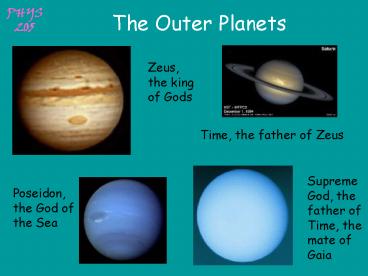The Outer Planets - PowerPoint PPT Presentation
1 / 36
Title: The Outer Planets
1
The Outer Planets
Zeus, the king of Gods
Time, the father of Zeus
Supreme God, the father of Time, the mate of Gaia
Poseidon, the God of the Sea
2
and Pluto with Charon
3
Characteristics
- There is a lot of water ice
- Massive cores as a result of larger spacing.
- Reducing chemistry.
4
Exploration
- Pioneer 10 (72) Jupiter (73)
- Pioneer 11 (73) Jupiter (74) and Saturn (79)
- Voyager 1 (77) Jupiter (79) and Saturn (80)
- Voyager 2 (77) Jupiter (79), Saturn (81),
Uranus (86) and Neptune (89) - Galileo (89) Jupiter (95)
- Cassini (97) Saturn (04)
5
Basic Properties of the Jovian Planets
Planet Distance Period Diameter Mass Density
Rotation
Jupiter 5.2 11.9
142800 318 1.3 9.9 Saturn 9.5 29.5
120540 95 0.7 10.7 Uranus 19.2
84.1 51200 14 1.2 17.2 Neptune
30.1 164.8 49500 17 1.6 16.1
Planet Satellites Jupiter 35 Saturn
30 Uranus 15 Neptune 8
Planet Internal Structures Jupiter H2,
metallic H2, Ice, Rock Saturn H2, metallic H2,
Ice, Rock Uranus H2, Ice, Rock Neptune H2, Ice,
Rock
6
Jupiter
7
Storms on Jupiter
Internal energy source -gt heated from below -gt
turbulance
8
GRS with Io and Europa
9
GRS
10
GDS
11
Neptune
12
High Clouds on Neptune
13
Saturn
14
Uranus
15
Jupiters Rings
16
Rings of Saturn
17
Rings of Uranus
18
Neptunes Rings
19
Shoemaker-Levy 9
20
Comet Shoemaker-Levy 9
- Comet SL9 was discovered by Eugene and Carolyn
Shoemaker and David Levy in 1993. Shortly after
its discovery it was determined to be in a highly
elliptical path near Jupiter and on a collision
course. - The size and mass of the original body and the
individual fragments is estimated to be from 2 to
10 km in diameter for the original body and 1 to
3 km for the largest fragments. - Between 16 July 1994 and 22 July 1994 the
fragments impacted the upper atmosphere of
Jupiter. This was the first time that scientists
had an opportunity to witness the collision of
two extraterrestrial bodies. - The impacts were observed by virtually every
large ground based telescope, thousands of small
and amateur telescopes, and several spacecraft
including HST and Galileo. - The pictures were posted to the Net within hours
of the impacts and caused severe overloading on
some ftp and WWW sites.
21
SL9 Approaching Jupiter
22
Visible Impacts of SL9
23
SL9 in ultraviolet
24
Cassini Mission
- Cassini is a joint NASA/ESA project designed to
accomplish an exploration of the Saturnian system
with its Cassini Saturn Orbiter and Huygens Titan
Probe. Cassini was launched 1997 Oct 15. En route
to Saturn, Cassini will first execute two gravity
assist flybys of Venus, then one of Earth, and
then one of Jupiter. It will arrive at Saturn on
2004 July 1. Near the end of this initial orbit,
the Huygens Probe separates from the Orbiter and
descends through the atmosphere of Titan. The
Orbiter relays the Probe data to Earth for about
3 hours while the Probe enters and traverses the
cloudy atmosphere to the surface. After the
completion of the Probe mission, the Orbiter
continues touring the Saturnian system for three
and a half years. Titan synchronous orbit
trajectories will allow about 35 flybys of Titan
and targeted flybys of Iapetus, Dione and
Enceladus. - The objectives of the mission are threefold
conduct detailed studies of Saturn's atmosphere,
rings and magnetosphere conduct close-up studies
of Saturn's satellites, and characterize Titan's
atmosphere and surface. - One of the most intriguing aspects of Titan is
the possibility that its surface may be covered
in part with lakes of liquid hydrocarbons that
result from photochemical processes in its upper
atmosphere. These hydrocarbons condense to form a
global smog layer and eventually rain down onto
the surface. The Cassini orbiter will use onboard
radar to peer through Titan's clouds and
determine if there is liquid on the surface.
25
Cassini Trajectory
26
Cassini Around Saturn
27
Cassini Spacecraft
28
Cassini and Huygens
29
Cassini deploying Huygens
30
Cassini liftoff
31
Cassini on its way
32
and Pluto, the God of the Underworld
33
Outer Planets
34
Basic Properties of Pluto
- Distance 39.5 AU
- Period of Revolution 248.6 years
- Diameter 2310 km
- Mass 0.0025 Earth
- Density 2.1 g/cm3
- Period of Rotation 6.39 days
- Surface Nitrogen Ice
- Atmosphere N2
35
HST images
36
Pluto Landscape































